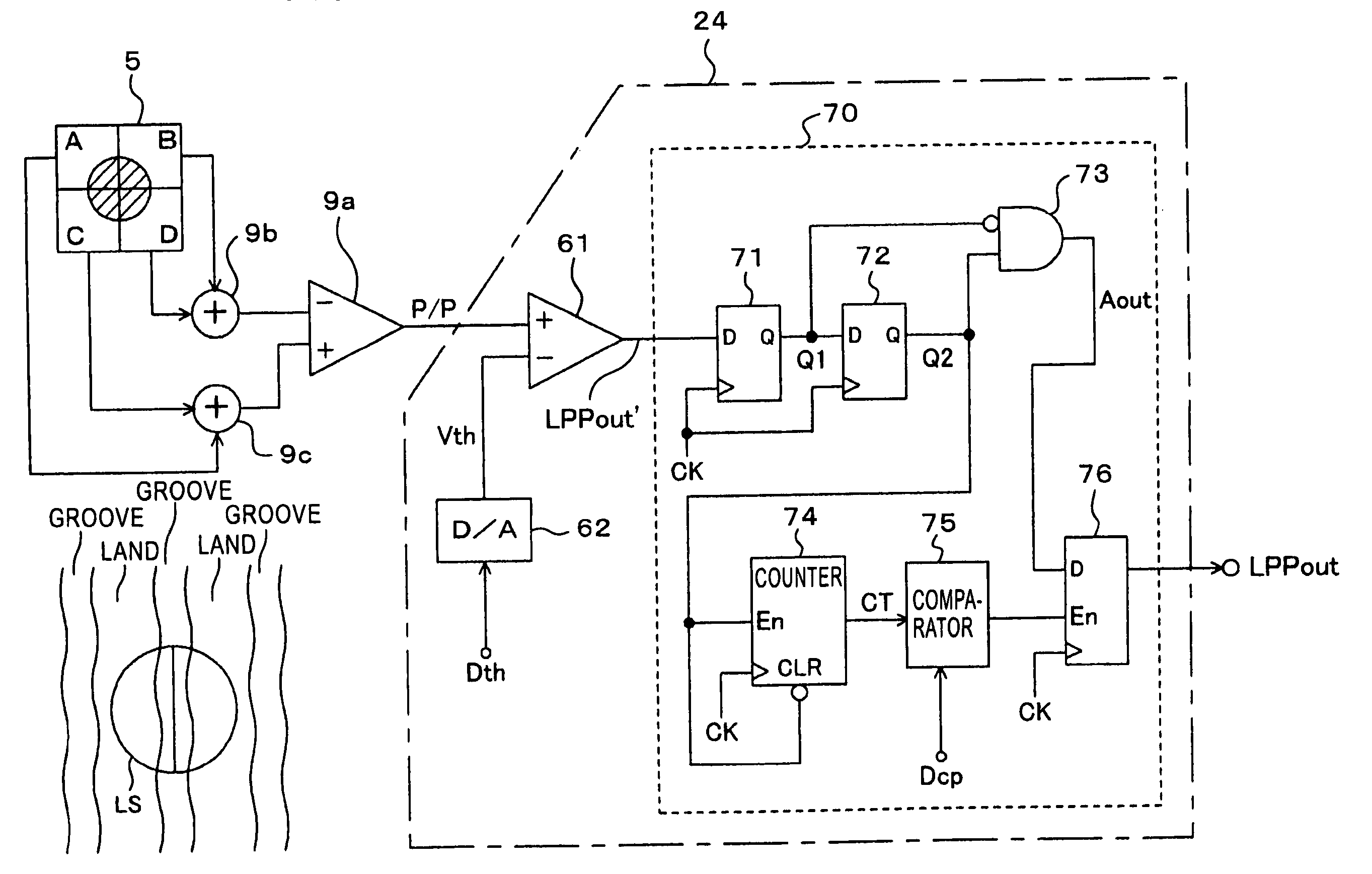Disk drive and detection method using pre-pit detection and push-pull signal generation
a detection method and pre-pit technology, applied in the direction of digital signal error detection/correction, instruments, recording signal processing, etc., can solve the problems of increasing the address error rate, difficult to correctly read the land pre-pits lpp, and recording marks (phase change bits) formed on the grooves
- Summary
- Abstract
- Description
- Claims
- Application Information
AI Technical Summary
Benefits of technology
Problems solved by technology
Method used
Image
Examples
first embodiment
[0127]In the disk drive 30 described above, a specific circuit configuration for detecting land pre-pits formed on a disk and the operation of the circuit, according to a first embodiment, are described below with reference to FIGS. 2 and 3.
[0128]Of various parts of the disk drive 30, a part serving to detect land pre-pits is shown in FIG. 2. The part includes the photodetector 5 of the pickup 1, the adders 9b and 9c and the differential amplifier 9a of the matrix circuit 9, and the land pre-pit extractor 24.
[0129]Although not shown in FIG. 2, the matrix circuit 9 includes not only the differential amplifier 9a and the adders 9b and 9c for generating the push-pull signal P / P but also a circuit part for generating the RF signal, the focus error signal FE, and the tracking error signal TE.
[0130]As shown in FIG. 2, the photodetector 5 is of the quadrant type including four photodetector elements A, B, C, and D. Light reflected from a disk is detected by respective photodetector element...
second embodiment
[0166]Referring to FIG. 4, a circuit configuration including a noise pulse remover 70 according to a second embodiment is described below. The circuit configuration is similar to that according to the first embodiment described above except that the noise pulse remover 70 is configured in an analog form.
[0167]As shown in FIG. 4, the noise pulse remover 70 includes a resistor R1, a diode D1, a capacitor C1, a comparator 77, and a reference voltage source 78.
[0168]In this circuit configuration, a detection signal LPPout', which might include noise pulses, is supplied from a comparator 61 to the noise pulse remover 70. In the noise pulse remover 70, when the detection signal LPPout' is at a level of “1”, the capacitor C1 is charged up by the detection signal LPPout' at a rate corresponding to the time constant determined by the resistance R1.
[0169]The charged voltage of the capacitor C1 varies in a similar manner to the count value CT shown in FIG. 3(e) according to the first embodimen...
third embodiment
[0174]Referring to FIGS. 5 and 6, a circuit configuration including a noise pulse remover 70 according to a third embodiment is described below. The circuit configuration is similar to that according to the first embodiment described above except that the noise pulse remover 70 is formed using a shift register.
[0175]In this third embodiment, the noise pulse remover 70 includes a shift register composed of n flip-flops SR1 to SR(n) and a pulse length detector 79 to which latched signals are supplied from the respective flip-flops SR1 to SR(n).
[0176]In the pulse length detector 79, a set value CL is given by the system controller 10, and if outputs of as many or more flip-flops than the set value CL are “1”, the output of the pulse length detector 79 becomes “1”. The pulse length detector 79 may be realized, for example, using a multiinput AND gate.
[0177]FIG. 6 shows waveforms associated with the operation of the noise pulse remover 70.
[0178]Also in this noise pulse remover 70, as sho...
PUM
 Login to View More
Login to View More Abstract
Description
Claims
Application Information
 Login to View More
Login to View More - R&D
- Intellectual Property
- Life Sciences
- Materials
- Tech Scout
- Unparalleled Data Quality
- Higher Quality Content
- 60% Fewer Hallucinations
Browse by: Latest US Patents, China's latest patents, Technical Efficacy Thesaurus, Application Domain, Technology Topic, Popular Technical Reports.
© 2025 PatSnap. All rights reserved.Legal|Privacy policy|Modern Slavery Act Transparency Statement|Sitemap|About US| Contact US: help@patsnap.com



